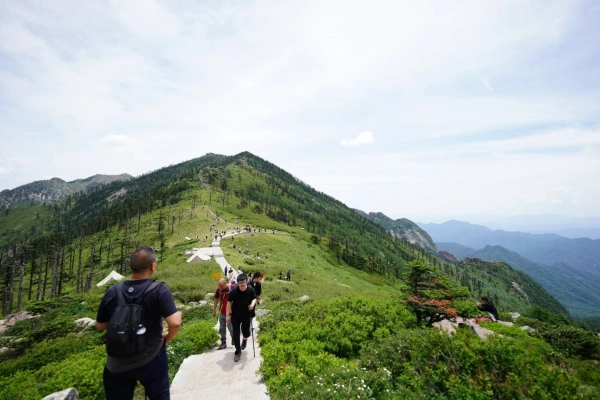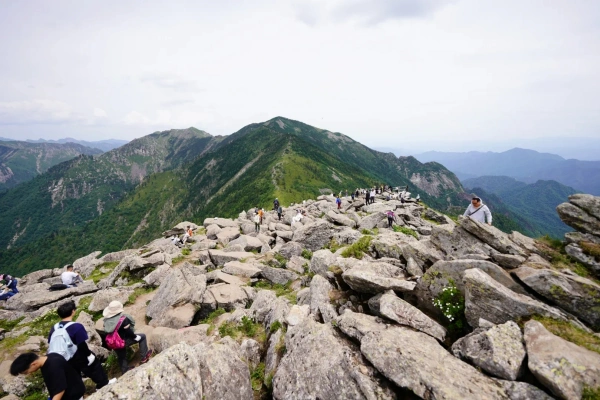Zhuque National Forest Park
Historical Overview
The park’s history dates back to its official establishment in 1999, when it was founded with a focus on ecological conservation and sustainable tourism. In the early 2000s, infrastructure expanded significantly, including the construction of the Zhuque Peak Observation Deck and the Ice Crystal Valley Trail, which opened up remote areas to visitors. The 2010s saw the introduction of eco-education programs in partnership with local universities, alongside the launch of annual "Qinling Ecology Festivals" to promote environmental awareness. In 2020, the park was recognized as a "National Geopark" for its unique geological formations, such as granite cliffs and glacial relics. Most recently, in 2023, it collaborated with international conservation organizations to protect endangered species like the golden snub-nosed monkey, cementing its role as a leader in sustainable tourism.
Structural Layout
The park’s layout seamlessly blends natural landscapes with thoughtfully designed facilities, divided into five key zones. The Entrance Zone features a Visitor Center with interactive exhibits on Qinling ecology and a 3D model of the park, alongside a Service Hub offering restrooms, a first-aid station, and a souvenir shop. The Core Scenic Zone includes Zhuque Peak, accessible via a 3-hour hike or cable car, and the Ice Crystal Valley, a 5-km trail winding through waterfalls and moss-covered rocks. The Cultural Zone showcases Ancient Temple Ruins from the Tang Dynasty and a Folk Culture Village highlighting traditional Shaanxi crafts. The Eco-Education Zone houses a Nature Museum with local wildlife specimens and a Workshop Area for hands-on activities like seed planting. Finally, the Adventure Zone offers a Rock Climbing Wall and a Zip-Line Course for thrill-seekers.
Major Attractions
Zhuque Peak Observation Deck stands out as a must-visit, featuring a glass-floored platform at 3,000 meters where visitors can "walk on clouds" during sunrise or sunset. The Ice Crystal Waterfall transforms from an 80-meter frozen cascade in winter to a thunderous torrent in summer, captivating all who see it. The Tang Dynasty Temple Ruins, with their stone pillars and lotus-patterned tiles, reflect the area’s historical significance as a pilgrimage site. The Qinling Wildlife Corridor, a protected passage for animals like takins and serows, can be observed via hidden cameras linked to the visitor center’s live feed. Lastly, Sky Mirror Lake, a high-altitude lake reflecting the surrounding peaks, offers a tranquil spot for photography and meditation.

Suggested Itineraries
For a Half-Day Light Exploration lasting three to four hours, start at the Entrance Zone before heading to Ice Crystal Valley for a 1.5-hour hike. Take the Zhuque Peak Cable Car for a 30-minute ascent, then spend 20 minutes at the Observation Deck. After lunch at the Folk Culture Village, visit the Nature Museum for 40 minutes before returning via the scenic shuttle bus. This itinerary highlights iconic views, waterfalls, and cultural insights. A Full-Day Adventure of six to seven hours begins with a three-hour hike to Zhuque Peak, followed by time at the Observation Deck and a picnic in the alpine meadows. In the afternoon, explore Ice Crystal Valley, visit the Temple Ruins, try rock climbing for an hour, and end with a sunset at Sky Mirror Lake. This route combines physical challenge, cultural immersion, and natural beauty. The Family-Friendly Route, spanning four to five hours, starts at the Entrance Zone with an Eco-Education Workshop for an hour, followed by an hour at the Folk Culture Village. In the afternoon, enjoy the Zip-Line Course for 30 minutes, visit the Nature Museum, and take a short hike to a nearby waterfall. This option emphasizes interactive learning, gentle activities, and wildlife engagement.
Ticket Purchase
Tickets can be purchased online via the official WeChat account "Zhuque Forest Park" up to three days in advance or on platforms like Ctrip. On-site tickets are available at the ticket office, which is open from 7 AM to 5 PM, though lines are shorter before 9 AM. Standard entry costs 45 yuan during peak season (April to October) and 30 yuan during off-season (November to March). The cable car is 80 yuan one-way or 150 yuan round-trip, operating from 8 AM to 5 PM weather permitting. Guided tours range from 200 to 500 yuan per group for two-hour English or Chinese tours covering ecology or history. Admission is free for children under 1.2 meters, disabled visitors, and seniors over 70.
Transportation
To reach the park by subway, take Line 2 to Weiqunan Station and transfer to the park shuttle bus for a 40-minute ride costing 15 yuan. By bus, Tourist Bus Line 3 from Xi’an South Bus Station goes directly to the park entrance for 25 yuan, taking 1.5 hours. A taxi ride from downtown Xi’an costs between 120 and 150 yuan and takes about an hour. Parking is available in a large lot at the entrance for 10 yuan per day, with electric vehicle charging stations on-site.

Best Time & Tips
To avoid crowds, steer clear of peak hours between 10 AM and 2 PM on weekends and holidays. The best times to visit are early mornings, arriving by 8 AM, or late afternoons after 3 PM on weekdays. The quietest days are Tuesdays through Thursdays, as Mondays are open but less busy than weekends. Spring (April to June) and autumn (September to October) offer mild temperatures and clear skies, while winter (December to February) is ideal for ice formations but requires warm clothing. Essential tips include downloading the park’s AR app for trail maps and wildlife info, wearing sturdy shoes as trails can be steep and muddy, and bringing snacks and water (refill stations are located at the visitor center and mid-trail huts). Photography is allowed everywhere except inside the Nature Museum’s sensitive zones, and prohibited items include drones, loudspeakers, and open fires.
Cultural Significance
Zhuque National Forest Park is not just a natural wonder but also a living testament to China’s cultural reverence for mountains. The name "Zhuque" refers to the Vermilion Bird, a mythical creature symbolizing the south in Chinese cosmology, linking the park to ancient Daoist beliefs about harmony with nature. Local legends say the park’s peaks were once the abode of immortals, while its forests inspired Tang Dynasty poets like Li Bai. Today, the park hosts annual "Mountain Worship Ceremonies," where visitors light incense and offer prayers for health and prosperity, blending ecological awareness with spiritual tradition. This cultural layer adds depth to every hike, making Zhuque a place where nature and history walk hand in hand.

